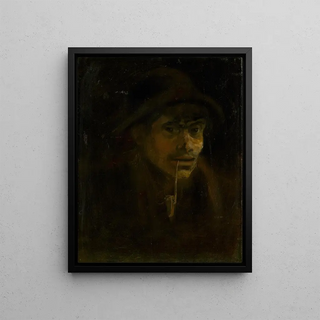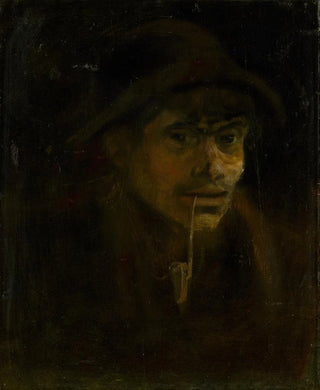Art print | Clochard avec une pipe - Ladislav Mednyánszky


View from behind

Frame (optional)
In the world of art, some works transcend their era and transport us into a universe where emotions and stories intertwine with rare intensity. "Clochard avec une pipe" by Ladislav Mednyánszky is one of those creations that capture the very essence of human life, with a depth and sensitivity that make it timeless. This piece, which evokes solitude and melancholy, invites us to explore the nuances of existence through the gaze of a man whose story is inscribed in every brushstroke. Contemplating this art print, the viewer is immediately immersed in a silent dialogue with the subject, an invitation to reflect on the human condition.
Style and uniqueness of the work
The strength of "Clochard avec une pipe" lies in Mednyánszky's unique style, which combines realism and impressionism. The meticulous details of the protagonist's face, as well as the play of light dancing across his features, testify to undeniable technical mastery. Every shadow, every reflection, seems to tell a story, revealing the hidden emotions behind the contemplative gaze of this man. The pipe, a symbol of contemplation and reflection, adds an extra dimension to the piece, suggesting a moment of pause amid life's tumult. The color palette, both sober and rich, enhances the poignant atmosphere of the scene, inviting the viewer to question the past of this enigmatic character. Thus, the singularity of this art print resides in its ability to evoke deep feelings while maintaining a respectful distance, allowing each person to project their own reflections onto it.
The artist and his influence
Ladislav Mednyánszky, an emblematic figure of Hungarian painting, established himself through his humanist approach to art. Born in 1852, this artist was influenced by the artistic movements of his time but also cultivated a personal style that is uniquely his own. His interest in scenes of daily life, often imbued with melancholy, testifies to a keen sensitivity to the social realities of his era. Mednyánszky was able to capture the soul of the characters

Matte finish

View from behind

Frame (optional)
In the world of art, some works transcend their era and transport us into a universe where emotions and stories intertwine with rare intensity. "Clochard avec une pipe" by Ladislav Mednyánszky is one of those creations that capture the very essence of human life, with a depth and sensitivity that make it timeless. This piece, which evokes solitude and melancholy, invites us to explore the nuances of existence through the gaze of a man whose story is inscribed in every brushstroke. Contemplating this art print, the viewer is immediately immersed in a silent dialogue with the subject, an invitation to reflect on the human condition.
Style and uniqueness of the work
The strength of "Clochard avec une pipe" lies in Mednyánszky's unique style, which combines realism and impressionism. The meticulous details of the protagonist's face, as well as the play of light dancing across his features, testify to undeniable technical mastery. Every shadow, every reflection, seems to tell a story, revealing the hidden emotions behind the contemplative gaze of this man. The pipe, a symbol of contemplation and reflection, adds an extra dimension to the piece, suggesting a moment of pause amid life's tumult. The color palette, both sober and rich, enhances the poignant atmosphere of the scene, inviting the viewer to question the past of this enigmatic character. Thus, the singularity of this art print resides in its ability to evoke deep feelings while maintaining a respectful distance, allowing each person to project their own reflections onto it.
The artist and his influence
Ladislav Mednyánszky, an emblematic figure of Hungarian painting, established himself through his humanist approach to art. Born in 1852, this artist was influenced by the artistic movements of his time but also cultivated a personal style that is uniquely his own. His interest in scenes of daily life, often imbued with melancholy, testifies to a keen sensitivity to the social realities of his era. Mednyánszky was able to capture the soul of the characters






